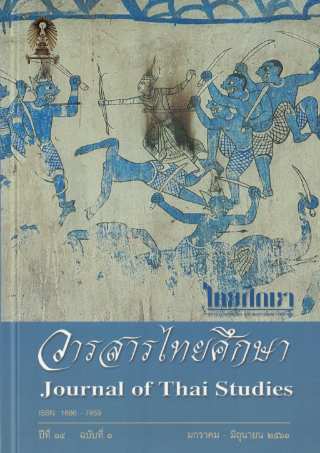Phenomenon of Belief in Rahu: Dynamics of Symbol Transmission and Creation in Thai Arts
Main Article Content
Abstract
This research focuses on the creation and succession of the Rahu symbol in Thai art, as well as the importance of the belief in Rahu in Thai society in the central, eastern and western regions by using field observation method, together with participant observation. The study of the succession of Rahu in Thai art found that there are two types of such representations: sculpture and Thai painting, including murals. The research found that the succession of the Rahu symbol in Thai art has been the result of the concept of Rahu according to Buddhism.
The research found that the concept of Rahu incorporates Brahman-Hindu ideas, but was created in a Buddhist context as it is used in Buddhist settings. The study found that the Rahu symbol is used in three ways. First is the idea of the creation of the Buddhist site as the center of the universe. Second is the idea of worshiping the Buddha in the future. The last factor is the idea of using Rahu to teach morals in Thai society. The symbolism of Rahu in art has four main factors. First, there is the idea of astrology in Thai society. Second are the characteristics and phenomena of Buddhism in Thai society, categorized into two factors: 1) popular Buddhism and 2) Buddhist commercialism. Third is the role of Rahu as a universal symbol in Thai society. Lastly, a new meaning of Rahu in Thai society can be classified into three meanings: 1) Rahu: the symbol for elimination of evil; 2) Rahu: the symbol of fortune; and 3) Rahu: the symbol of change.
Article Details

This work is licensed under a Creative Commons Attribution-NonCommercial-NoDerivatives 4.0 International License.
Journal of Thai studies is licensed under a Creative Commons Attribution-Noncommercial-NoDerivatives4.0 Intenational (CC BY-NC-ND 4.0) licence, unless otherwise stated. Plese read our Policies page for more information on Open Access, copyright and permissions.
References
ภาษาไทย
กรมศิลปากร. (๒๕๔๖). วัดพุทไธศวรรย์. กรุงเทพฯ: โรงพิมพ์คุรุสภาลาดพร้าว.
ขนิษฐา มากทวี. (๒๕๕๓). คติความเชื่อเรื่องพระราหูในวัฒนธรรมลาวในภาคตะวันออกเฉียงเหนือ. วิทยานิพนธ์ปริญญาศิลปศาสตรมหาบัณฑิต สาขาวิชาโบราณคดี คณะโบราณคดี บัณฑิตวิทยาลัย มหาวิทยาลัยศิลปากร.
สันติ เล็กสุขุม และกมล ฉายาวัฒนะ. (๒๕๒๔). จิตรกรรมฝาผนังสมัยอยุธยา. กรุงเทพฯ: เจริญวิทย์การพิมพ์.
เสมอชัย พูลสุวรรณ. (๒๕๓๙). สัญลักษณ์ในงานจิตรกรรมไทย. กรุงเทพฯ: สำนักพิมพ์มหาวิทยาลัยธรรมศาสตร์.
อภิวันทน์ อดุลยพิเชฎฐ์. (๒๕๕๗). จิตรกรรมฝาผนังวัดราชสิทธาราม. กรุงเทพฯ: เมืองโบราณ.
ภาษาอังกฤษ
Stephen Markel. (๑๙๙๐). The Imagery and Iconographic Development of the Indian Planetary Deities Rāhu and Ketu. Journal South Asian Studies.
